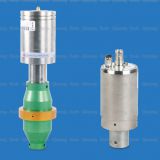High Power 20Khz 3300w Ultrasonic Welding Transducer Replacement Branson CJ20
USD $460 - $580 /Piece
Min.Order:1 Piece
Quick Details View All >
Hangzhou Qianrong Automation Equipment Co.,Ltd.
20Khz 2000w Ultrasonic Replacement Dukane 110-3122 Converter
2600w High Power 15Khz Ultrasonic Transducer with Booster with PZT4 Ceramics
15 KHz 2600W 60mm Piezoelectric Ultrasonic welding Transducer , Good Heat Resistance
3600W 15Khz 70mm Piezoelectric Ultrasonic welding Transducer for Plastic Welding Machine
20 khz 1500w 50mm piezoelectric ultrasonic welding transducer with import superior ceramic disc
Product Details
High Power 20Khz 3300w Ultrasonic Welding Transducer Replacement Branson CJ20
Description:
Ultrasonic Converters and Ultrasonic Transducers are one in the same. There is one Ultrasonic OEM, Dukane Corporation, that uses the term Transducer. All of the other ultrasonic OEM manufactures such as Branson, Sonics and Materials, Rinco, Telesonics and Herrmann refer to these as Converters or Konverters.
Converters or Transducers all do the same thing…convert electrical energy to mechanical movement…so we have our electrical charge being introduced across the surface of the ceramics at the desired frequency which in turn gives us a movement or vibration at the working end on the converter.
The converter is threaded onto a booster, which increases, decreases or just transfers the amount of movement from the face of the converter to the horn or Sonotrode as we call it.
Specifications:
| Model | QR-5020-CJ20 |
| Frequency | 20 khz |
| Output power | 3300 watt |
| Joint bolt | 1/2-20UNF |
| Ceramic disc Diameter | 50mm |
| Qty of ceramic discs | 4pcs |
| Capacitance | 18-20nf |
| Amplitude | 10 um |
| Application | Plastic welding machine |
The physical definition of a wave is that the transmission of vibration in an object forms a wave. There must be two conditions for the formation of such waves: one is the source of vibration and the other is the propagation medium. The classification of waves generally has the following types: First, classification according to the direction of vibration and the direction of propagation. When the direction of vibration is perpendicular to the direction of propagation, it is called a transverse wave. When the direction of vibration coincides with the direction of propagation, it is called a longitudinal wave. Second, according to the frequency classification, we know that the human ear sensitive hearing range is 20HZ-20000HZ, so the wave within this range is called sound wave. Waves below this range are called infrasound waves, and waves above this range are called ultrasonic waves.
Contact Supplier

You May Like






New Products
Popular Searches
Recommended Products
Find Similar Products By Category